Adobe Flash Pro Cs6 Free Download With Crack
Our Verdict
It's difficult not to recommend Adobe Illustrator CS6 - what it adds are a number of workflow and creative-focused tools that are genuinely excellent. The application looks slicker, is much faster and for the £190 standalone upgrade it's worth the cash. The minor additions make Adobe Illustrator CS6 a more rounded, quicker to navigate and use application, whereas the bigger additions - especially the pattern creation tools - make it a more versatile and powerful piece of software. When it comes to the crunch, if you use any kind of patterns within your work, it's a no-brainer. if you're just using Illustrator to design letterforms, create logos or design simple line drawings, you'll probably be happy sticking with the version you've got. Still, a really, really good release. We like the redesigned interface, the intelligent tweaks to panels, the speed and the incredible new pattern creation tools. For Illustrator users working with patterns in any way, the new functionality is intuitive and extremely powerful. We dislike? Actually, there's not much to dislike.
For
- Fast!
- Excellent pattern creation tools
- Gradients on strokes
- Better image tracing
Against
- Not much has been added since CS5
Creative Bloq Verdict
It's difficult not to recommend Adobe Illustrator CS6 - what it adds are a number of workflow and creative-focused tools that are genuinely excellent. The application looks slicker, is much faster and for the £190 standalone upgrade it's worth the cash. The minor additions make Adobe Illustrator CS6 a more rounded, quicker to navigate and use application, whereas the bigger additions - especially the pattern creation tools - make it a more versatile and powerful piece of software. When it comes to the crunch, if you use any kind of patterns within your work, it's a no-brainer. if you're just using Illustrator to design letterforms, create logos or design simple line drawings, you'll probably be happy sticking with the version you've got. Still, a really, really good release. We like the redesigned interface, the intelligent tweaks to panels, the speed and the incredible new pattern creation tools. For Illustrator users working with patterns in any way, the new functionality is intuitive and extremely powerful. We dislike? Actually, there's not much to dislike.
Pros
- + Fast!
- + Excellent pattern creation tools
- + Gradients on strokes
- + Better image tracing
Cons
- - Not much has been added since CS5
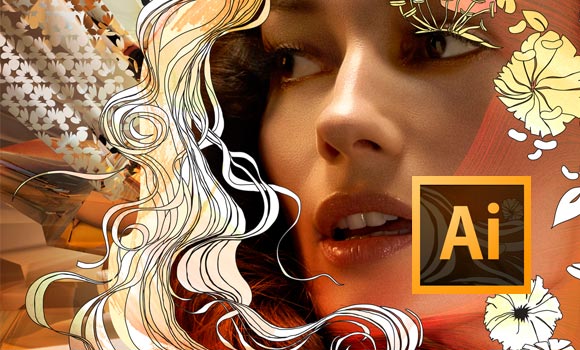
Adobe Illustrator is the industry standard tool for vector drawing and illustration, used by a wide variety of creative professionals including editorial illustrators, identity designers, textile and pattern designers, UI designers, motion artists and many others. It's always been an incredibly versatile tool, thanks to a broad feature set, and of course the fact that vector graphics are infinitely scaleable and in most cases relatively lightweight.
Over the years the application has been given some quite remarkable features - from the Gradient Mesh in the 1998 release of version 8 to multiple art boards in CS4 and the Perspective Grid in CS5 (which Adobe ported across from FreeHand, the tool it bought from Macromedia and then phased out), it is a behemoth of an application, whether you want to create photorealistic illustrations or slick logos. So, what has Adobe done in Adobe Illustrator CS6? A facelift, some speed improvements, a few tweaks and one major addition that illustrators and designers in particular will love are all on the agenda.
The interface in Adobe Illustrator CS6
The first thing you notice about Adobe Illustrator CS6 is that it looks different. If you've seen Photoshop CS6 you won't be that surprised - by default it's charcoal grey. Like Photoshop, it gives Illustrator an undeniably more professional feel. The thing is, it doesn't really feel like Illustrator to a user of many years. It feels more like a post production tool - matching that of After Effects. But this is a minor, minor gripe.
In fact, it's not even a gripe, it's purely an observation. And, designers and illustrators being the creatures of habit that they are, the most likely thing they'll do is go to Illustrator>Preferences>User Interface and change the brightness setting back to Medium Light or light. Something in this preference pane that isn't in the Photoshop equivalent is a slider and percentage field, which enables you to set the brightness of the interface exactly how you want it.
Interface brightness
As you slide, the interface changes brightness. OK, it's not going to set the world on fire and get users queuing up to upgrade or sign up for Creative Cloud Membership, but it's a nice detail. As is the option to change the Canvas colour (the area around the artboard) to match the user interface or keep it as white as in previous releases. The main Tools panel also looks more refined, with redesigned tool icons. In fact, everything looks a bit more detailed, a bit more refined (and the Tools panel, in our opinion still looks better as one column). It's hard not to like the new interface - it feels like a modern step forward for the application.
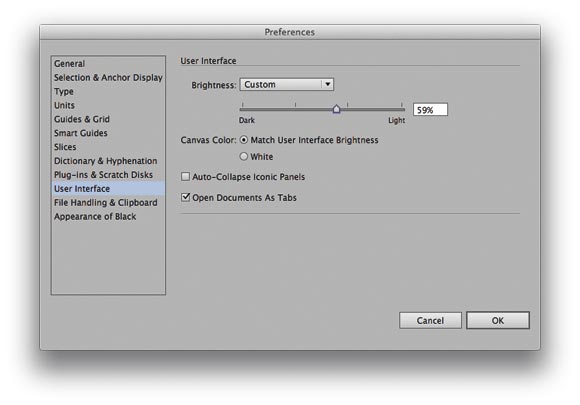
Tweaks for the hardcore
There are a few other tweaks to the interface that will definitely please hardcore users. The first is being able to edit layer names, swatch names, brushes, artboards and so on in their respective panels. In CS5.1 and earlier, you had to double-click the item you wanted to rename and then an intermittent dialog appeared where you'd rename it.
You can still do it this way if you like by double-clicking the item's icon (it gives you access to more options, as well) but it's quicker and easier to double-click on the items name (rather than its icon) and change it inline. Why wasn't this in IIlustrator before? No idea, but we're glad it is.
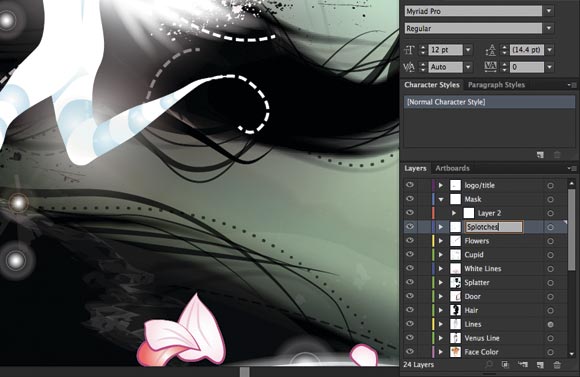
Adobe's thinking about workflow
The other tweaks are about as minor as they come - but again examples of Adobe thinking about its user's workflows with this release. For one, there's a new Make Mask/Release button in the Transparency panel. This certainly makes it quicker to work with opacity masks, saving you an albeit brief visit to the Transparency panel's flyout menu. Another example of this is the new expandable sampling area in the Color panel. Expand the panel by dragging its bottom-right corner and the expanded colour spectrum becomes visible. Compared to Illustrator CS5.1's tiny sampling area it's ace. Oh, and you can now copy and paste hex values directly from the Color panel.
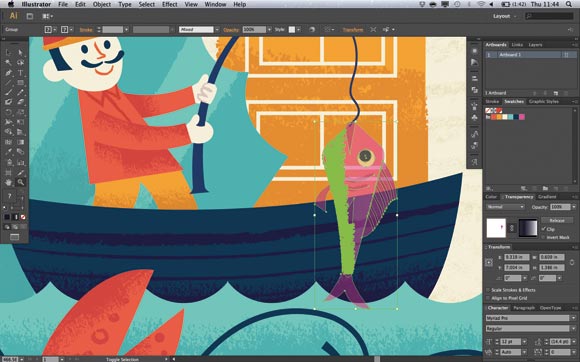
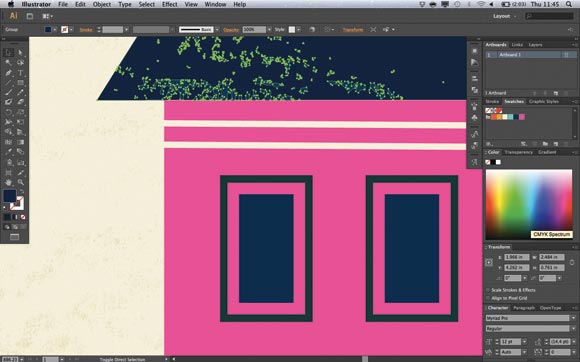
The Character panel
And there's more! The Character panel has had a minor tweak to enable you to cycle through fonts - seeing a preview on the artboard if the text is selected - using the arrow keys (it was available in Windows up until this release, but now is across both platforms). There's also new buttons for All Caps, Small Caps, Superscript and Subscript towards the bottom of the panel. We'll never complain about better text controls. The Transform panel also gets a Scale Strokes & Effects checkbox rather than it being tucked away in the Scale dialog.
In addition, the Control panel has been made a little more consistent when displaying content-sensitive information relating to tools and objects. And finally, when you tear off hidden tools you can now arrange them vertically to save a bit of desktop real estate - and dock them either like this or horizontally. All this is about making things a little quicker for the user - and the interface improvements are very welcome. Nice job.
Speed and specs
The other thing you notice when you open up Adobe Illustrator CS6 - or at least when you open up a complex file with many layers, complicated gradient mesh, many effects, feathering, transparency and thousands of points - is its speed. Adobe preached to us how fast Adobe Illustrator CS6 is, and it actually is blazing fast. You probably won't notice unless you're working on a complicated file - if you're designing a logo or similar you're unlikely to see any real improvement in redraw or usability.
The speed, we're told, is down to the rather nicely coined 'Mercury Performance System' and Adobe Illustrator CS6 being completely rewritten as a native 64-bit application on both Mac and PC. Whatever you put it down to, on a modern MacBook Air with 4GB RAM (Adobe recommends 8GB) it is very quick. On a Mac Pro it is going to fly. Seriously.
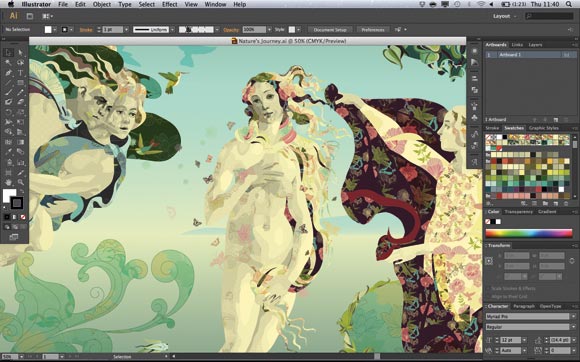
On the subject of specs, the bare minimum is Mac OS X 10.6.8 or 10.7 Lion; 2GB RAM; 2GB hard disk space; and 1024x768 resolution. If you're on Windows, you'll need XP with Service Pack 3 or Windows 7 with Service Pack 1; 1GB of RAM for 32-bit or 2GB RAM for 64-bit; and the rest the same as Mac. Of course though, these are the bare minimum system requirements: Adobe Illustrator CS6 will work, but it won't be that happy if you start experimenting with effects, gradients and transparencies.
The bigger features
So far, we've really focused on the workflow and speed enhancements in Adobe Illustrator CS6, but thankfully there are some creative additions - not as many as you might hope, but some. The first worth noting is being able to apply gradients to a stroke. You can now apply gradients along the length, across the width, or within the stroke itself. Big deal? Well, kind of - it opens up some nice creative possibilities. It's difficult to see why this hasn't been here before - it may be due to the amount of processing power Adobe Illustrator CS6 needs to calculate gradients applied to strokes.
What would you use this for? Adding highlights to photorealistic artwork or creating faux 3D effects are just two examples. This feature requires a little bit of a reshuffling of the Gradient panel. Below the Type dropdown - where you specify a Linear or Radial gradient - and above the gradient angle, there's three new Stroke options. These, from left-to-right enable you to apply a gradient within the stroke, along the stroke or across the stroke.
Applying the gradient within the stroke enables you to change the angle of the gradient within the stroke; along the stroke places the gradient along your path (use the Reverse Gradient button to change the direction); and across the stroke places the gradient across the width of the stroke that you've specified. Used in conjunction with some of Illustrator's art brushes, it's a powerful tool - especially if you're building up complex (and maybe photorealistic) illustrations.
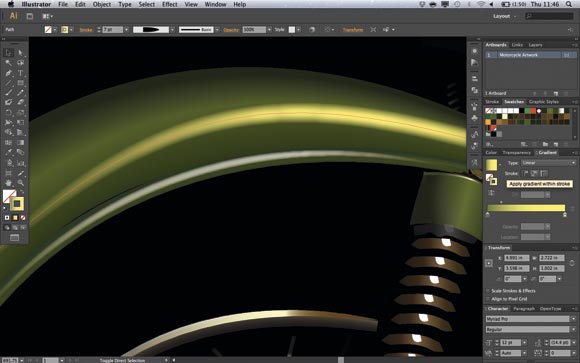
Image Trace in Illustrator CS6
Illustrator is a little misunderstood sometimes. And it's probably because of its ability to trace raster images to create vector graphics. How many bad portraits have you seen that have been traced using Illustrator's Live Trace tool? Anyhow, we digress, but there is a point to our slight rant: Adobe Illustrator CS6 sees the end of Live Trace, bringing in a new tracing tool and engine housed in the Image Trace panel. And what a panel it is.
When you place a raster image in Adobe Illustrator CS6 (JPEG, TIFF and so on) you access Image Trace one of two ways. By the presets in the Control Panel (you can create your own presets - more on this in a bit) or by using the comprehensive Image Trace panel under Window>Image Trace. There are five options that run across the top of the panel, which are separate to the presets - think of them as starting points. These are: Auto-Color, High Color, Low Color, Greyscale, Black and White and Outline. Once you've applied a starting point, the main slider within the panel changes contextually, giving you further control.
Add more colours
It gives you options for adding more colours in the 'Color' starting points, Greys in Greyscale mode and Threshold in Black and White and Outline modes. You can choose different views as you're tracing: Tracing Result, which shows the final trace; Tracing Result with Outlines, showing paths; Outlines; Outlines with Source Image; and Source Image. At any time press and hold the small eye next to this dropdown to view the source image.
Using Presets
Above the View dropdown is the Presets dropdown. This gives you access to some common uses for tracing - High Fidelity Photo, Black and White Logo and Line Art being the most obviously useful (the rest are Low Fidelity Photo, 3 Colors, 6 Colors, 16 Colors, Shades of Gray, Sketched Art, Silhouettes and Technical Drawing). But of course, you can save your own presets using the menu next to the Preset dropdown.
This all offers a certain amount of control over tracing, but there's a bit more to the panel. Expand the Advanced settings and you have control over Paths, Corners, Noise and different methods of tracing - where Adobe Illustrator CS6 either creates cutout or overlapping paths. You can also specify to replace slightly curved lines with straight ones by checking the Snap Curves to Lines box and set white fills to none using the Ignore White checkbox. You also get a neat readout of how many paths, anchors and colours are being generated by the trace.
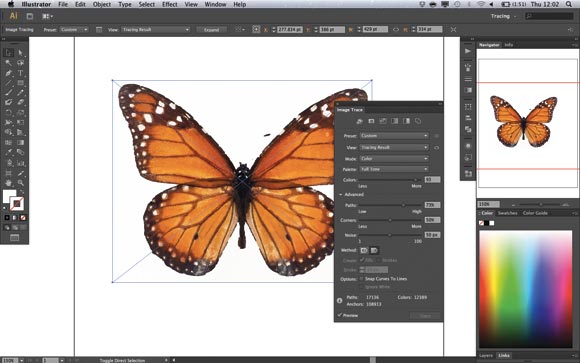
Image Trace: the results
So how does it do? Well, much better than Live Trace, especially on full-colour photos. And like everything else in Illustrator, it's extremely fast. Whilst you're not going to use it to trace photos on a daily basis (even though it does a pretty good job) for quickly tracing sketches of logos and line drawings, it works exceptionally well once you've mastered the array of advanced sliders. Sketches will still need cleaning up, and there's nothing better than a hand-trace to make sure you manage paths and anchors correctly, but it's an improvement on Live Trace and a welcome addition. There's even a new Tracing workspace which sets up the most useful panels for tracing including Color, Navigator and of course Image Trace.
Another feature of note is the improved Guassian Blur Effect. The Guassian Blur in CS5.1 gave you a tiny preview of the effect. In Adobe Illustrator CS6 you preview your blur on the artboard - if the Preview box is checked as you ramp up the slider your selected object blurs in real time. And once again, it's fast.

The big feature in Illustrator CS6 is ...
Usually, an upgrade has a killer feature. Something that users just cannot imagine not having. If there's one feature that fits this mould it's Adobe Illustrator CS6's new Pattern Creation tools. It may not sound as sexy as Photoshop's Content-Aware Move or 3D functionality, but it's actually, if you'll pardon us for one moment, bloody brilliant.
Patterns are something designers and illustrators create in Illustrator on an almost daily basis. And this changes things in a big way. Creating patterns pre-CS6 was a little clunky. Create your objects, go to Edit>Define Pattern and then apply that swatch to your object. If you want to edit the pattern it was difficult, and lining up a tiled repeat using a pattern swatch was often frustrating. CS6 changes this.
Pattern Options panel
Here's a typical workflow to show you how easy it is to create repeat patterns. First, open or draw your objects, select them and then go to Object>Pattern>Make. Your object is immediately repeated according to the settings in the new Pattern Options panel. Your pattern swatch is added to the Swatches panel but you can edit in Pattern Creation Mode until you're happy, finalising the swatch by hitting Done. We'll go back to the Swatches panel in a moment.
The Pattern Options panel gives you a huge amount of control over your patterns. You can change the tile type (even interactively tweaking the tiling using the Pattern Tile tool - accessed from the panel), spacing, copies and more depending on the preset you've chosen. A very handy option is being able to dim copies of repeats within your pattern as you're working on it - so you know you're working on the original object. A slider and percentage field lets you edit the amount your repeats dim.
The killer feature
The killer feature though is being able to double-click on the pattern swatch in the Swatches panel at any time and re-edit the pattern. When you're finished editing and press Done, the pattern updates across all objects it's applied to. If you want to create a new pattern, hit Save a Copy. It's a brilliant toolset, brilliantly executed and truly useful for designers, illustrators and just about anyone who uses this piece of software on a regular basis. It's hard to say anything bad about it.
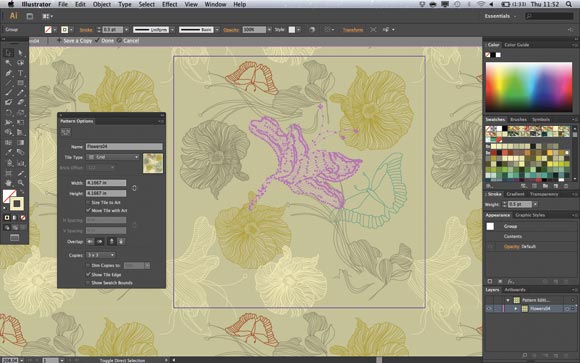
PRICE
Full £476 (ex VAT), Upgrade £190 (ex VAT), £38.11/month as part of annual Creative Cloud subscription and £57.17/month as part of month-by-month Creative Cloud subscription. For details on where to buy, please visit the Adobe Store.
SYSTEM SPECS
For system specifications for Adobe Illustrator CS6, and other apps in Adobe CS6, please visit our Adobe system specs page.
QUICK LINKS TO ADOBE CS6 REVIEWS:
Photoshop CS6
After Effects CS6
Dreamweaver CS6
Flash Pro CS6
InDesign CS6
Premiere Pro CS6
Adobe Illustrator CS6
It's difficult not to recommend Adobe Illustrator CS6 - what it adds are a number of workflow and creative-focused tools that are genuinely excellent. The application looks slicker, is much faster and for the £190 standalone upgrade it's worth the cash. The minor additions make Adobe Illustrator CS6 a more rounded, quicker to navigate and use application, whereas the bigger additions - especially the pattern creation tools - make it a more versatile and powerful piece of software. When it comes to the crunch, if you use any kind of patterns within your work, it's a no-brainer. if you're just using Illustrator to design letterforms, create logos or design simple line drawings, you'll probably be happy sticking with the version you've got. Still, a really, really good release. We like the redesigned interface, the intelligent tweaks to panels, the speed and the incredible new pattern creation tools. For Illustrator users working with patterns in any way, the new functionality is intuitive and extremely powerful. We dislike? Actually, there's not much to dislike.
Adobe Flash Pro Cs6 Free Download With Crack
Source: https://www.creativebloq.com/graphic-design-tips/adobe-illustrator-cs6-review-1233309
0 Response to "Adobe Flash Pro Cs6 Free Download With Crack"
Post a Comment